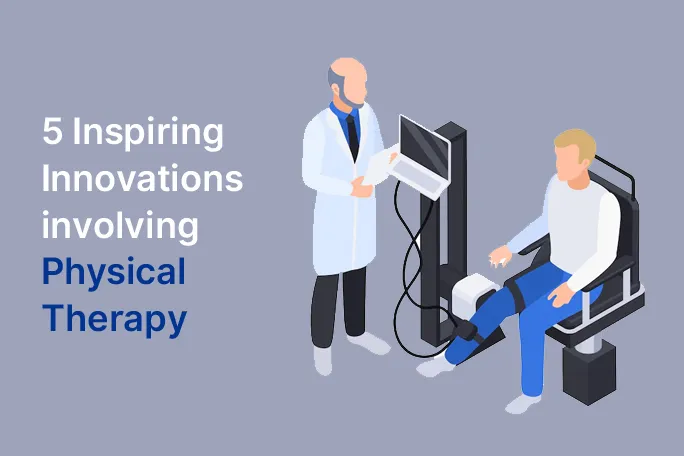
Physical therapy plays a crucial role in the overall healthcare system, offering a wide range of benefits that contribute to patients' well-being and recovery. From orthopedic and neurological rehabilitation to cardiovascular and pulmonary care, physical therapy is an integral part of healthcare facilities, providing essential services to patients of all ages and conditions. With a focus on personalized treatment plans and goal setting, physical therapists work collaboratively with other healthcare professionals to ensure the best possible outcomes for their patients. Despite facing challenges in access and insurance coverage, physical therapy continues to innovate and advance, incorporating new technologies and research to enhance patient care. Whether it's rehabilitation for post-operative patients, athletes with sports injuries, or individuals with chronic conditions, physical therapy plays a vital role in promoting recovery and improving quality of life. In this blog, we will explore the various types of physical therapy, the techniques and modalities used, the role of physical therapists in patient care, and the educational and training requirements for those pursuing a career in this essential healthcare profession.

Physical therapy plays a vital role in healthcare by providing treatment and rehabilitation for individuals with musculoskeletal, neurological, and other conditions. Through the use of therapeutic exercises, manual techniques, and specialized equipment, physical therapists help patients improve their mobility, reduce pain, and restore function. This not only enhances the quality of life for patients but also contributes to reducing the burden on healthcare systems by preventing long-term disability.
Healthcare facilities have increasingly integrated physical therapy into their services to offer comprehensive care to patients. By having dedicated physical therapy departments or partnering with external providers, hospitals and clinics can ensure that patients receive prompt access to rehabilitative services as part of their overall treatment plan. This approach not only improves patient outcomes but also promotes coordinated care among different healthcare professionals.
Regulations and standards for physical therapy in healthcare are crucial to ensure the safety and effectiveness of treatments provided to patients. Licensing requirements for physical therapists, accreditation of educational programs, and adherence to evidence-based practice guidelines are essential components that uphold the quality of care delivered. These measures aim to protect the public from substandard or unsafe practices while maintaining professional integrity within the field.
Orthopedic physical therapy focuses on the treatment of musculoskeletal injuries and conditions, such as fractures, sprains, strains, and post-operative rehabilitation. This type of therapy aims to improve mobility, reduce pain, restore function, and prevent disability through various exercises and manual techniques.
Neurological physical therapy is designed to help patients with neurological disorders or injuries, such as stroke, spinal cord injury, traumatic brain injury (TBI), multiple sclerosis (MS), Parkinson's disease, and others. The goal is to enhance the patient's quality of life by addressing movement impairments and promoting independence through specialized exercises and functional training.
Cardiovascular and pulmonary rehabilitation involve therapeutic interventions for individuals with heart or lung conditions. These may include cardiac rehabilitation for heart attack survivors or those with coronary artery disease, as well as pulmonary rehabilitation for patients with chronic obstructive pulmonary disease (COPD), asthma, cystic fibrosis or other respiratory disorders. The focus is on improving endurance levels and breathing patterns to optimize cardiovascular health.

Rehabilitation services, particularly physical therapy, play a vital role in the overall healthcare system. For post-operative patients, physical therapy can aid in the recovery process by restoring mobility and function. This not only enhances the patient's quality of life but also reduces the risk of complications and readmissions.
Individuals with chronic conditions also benefit greatly from rehabilitation services. Physical therapy can help manage pain, improve flexibility, and enhance overall strength and endurance. By incorporating these services into their treatment plan, patients with chronic illnesses can experience improved functionality and reduced dependency on medications.
Furthermore, rehabilitation services are essential for athletes recovering from sports injuries. Through targeted exercises and specialized treatments, physical therapists assist athletes in regaining strength, agility, and flexibility. This not only speeds up the recovery process but also helps prevent future injuries by improving biomechanics.
Manual therapy techniques are an essential aspect of physical therapy, involving hands-on methods to mobilize joints, improve range of motion, and reduce pain. These techniques may include soft tissue mobilization, joint manipulation, and manual traction. Manual therapy is often used in conjunction with other treatment modalities to enhance the overall effectiveness of the therapeutic plan.
Therapeutic exercise modalities play a crucial role in physical therapy by targeting specific muscle groups and movement patterns to improve strength, flexibility, endurance, and functional abilities. These exercises are tailored to each patient's individual needs and may include stretching exercises, resistance training, balance exercises, and cardiovascular conditioning. Therapeutic exercise modalities aim to restore optimal function while minimizing the risk of re-injury.
Electrotherapeutic modalities in physical therapy utilize electrical stimulation for pain management and tissue healing. This may involve the use of TENS (transcutaneous electrical nerve stimulation), ultrasound therapy, or electrical muscle stimulation. Electrotherapeutic modalities can help alleviate discomfort, reduce inflammation, promote circulation, and facilitate tissue repair as part of a comprehensive physical therapy treatment plan.
Physical therapists play a critical role in patient care through their expertise in assessment and diagnosis. They can identify the underlying physical issues and develop personalized treatment plans that address the specific needs of each patient.
In addition to providing therapy for physical ailments, physical therapists also work with patients to set realistic goals for their rehabilitation. This personalized approach ensures that patients receive targeted treatment and support as they work towards recovery.
Furthermore, physical therapists collaborate closely with other healthcare professionals such as physicians, nurses, and occupational therapists to ensure comprehensive care for their patients. Through this teamwork, they are able to provide holistic support and guidance throughout the patient's journey towards improved physical health.

One of the significant challenges in physical therapy is the barrier to access. Many individuals, particularly those living in rural or underserved areas, face difficulties in obtaining physical therapy services due to the limited availability of providers and facilities. This lack of access can negatively impact their ability to receive timely and effective treatment for various musculoskeletal, neurological, and other conditions that require physical therapy.
In response to these barriers, the field of physical therapy has seen a rise in innovative technologies aimed at improving accessibility and delivery of care. Telehealth platforms have emerged as a valuable tool for connecting patients with physical therapists remotely, allowing for virtual consultations, exercise demonstrations, and monitoring progress. Additionally, wearable devices and mobile applications are being integrated into treatment plans to enable patients to engage in home-based exercises while receiving real-time therapist feedback.
Furthermore, ongoing research efforts continue to drive advancements in the field of physical therapy. From novel treatment techniques for specific conditions to exploring the role of personalized medicine in optimizing rehabilitation outcomes, researchers are focused on enhancing the effectiveness and efficiency of physical therapy interventions. These developments hold promise for expanding access to care and improving patient outcomes across diverse populations.
Pediatric physical therapy focuses on helping children develop gross motor skills, improve balance and coordination, and recover from injuries or surgeries. It also addresses conditions such as cerebral palsy, developmental delays, and genetic disorders. The goal is to promote independence and participation in daily activities for children.
Geriatric physical therapy is designed to address the unique needs of older adults, including issues related to aging such as arthritis, osteoporosis, joint replacement surgery, and balance problems. This type of therapy aims to improve mobility, reduce pain, prevent falls, and enhance the overall quality of life for elderly individuals.
Physical therapy for individuals with disabilities aims to maximize functional abilities and promote inclusion in all aspects of life. This may involve improving mobility through exercises and assistive devices or developing strategies to perform activities of daily living independently. The focus is on enhancing independence and participation in work, school, or recreational activities.
Becoming a physical therapist requires obtaining a Doctor of Physical Therapy (DPT) degree from an accredited program. This typically involves completing three years of undergraduate education followed by three years in a graduate DPT program. Some programs may also offer combined bachelor’s and DPT degrees, allowing students to complete their education in six or seven years.
In addition to academic coursework, aspiring physical therapists must complete clinical training and practical experience. This often includes working under the supervision of licensed physical therapists in various healthcare settings such as hospitals, clinics, and rehabilitation centres. Clinical training provides hands-on experience working with patients and applying theoretical knowledge to real-life situations.
Once licensed, physical therapists are required to engage in continuing education and professional development activities to maintain their knowledge and skills. These may include attending workshops, and seminars, or pursuing advanced certifications in specialized areas of practice such as sports therapy or geriatric care.
Health insurance policies often cover physical therapy services, but the extent of coverage can vary widely. Some plans may limit the number of sessions or require pre-authorization, while others may offer more comprehensive benefits. It is important for patients to carefully review their insurance policy to understand what physical therapy services are covered and any associated costs.
Medicare and Medicaid also provide reimbursement for physical therapy services, with specific guidelines and requirements. Patients who are covered by these government programs should be aware of the eligibility criteria and limitations related to physical therapy benefits. Additionally, some private pay options and financial assistance programs may be available to help individuals access necessary physical therapy treatment while managing costs.
Understanding insurance coverage for physical therapy is crucial for ensuring that individuals receive the care they need without facing excessive financial burdens. By exploring different payment options and seeking information about available resources, patients can navigate the complexities of healthcare financing to access essential physical therapy services.
At Prime Chiro, we understand the importance of finding the best chiropractor near you in Lansvale NSW and nearby areas of Fairfield, Liverpool, and Cabramatta. Our team is dedicated to providing high-quality chiropractic care and consultation services to individuals in need. Whether you are experiencing back pain, neck pain, headaches, or other musculoskeletal issues, our experienced chiropractors are here to help. We offer personalized treatment plans to address your specific needs and get you back to feeling your best. Contact Prime Chiro today to schedule a consultation and take the first step towards better health and wellness.
Physical therapy is a healthcare profession that uses exercises, manual therapy, and other techniques to help people recover from injuries, manage pain, and improve their overall physical function.
Physical therapy can benefit a wide range of individuals, including those recovering from surgery, athletes with sports injuries, individuals with chronic pain or conditions like arthritis, and people looking to improve their mobility and strength.
Physical therapy plays a vital role in healthcare by providing non-invasive, drug-free treatment options for various conditions. It helps reduce pain, improve mobility, prevent further injuries, and enhance overall quality of life.
During a physical therapy session, you can expect a thorough evaluation of your condition, personalized treatment plans, exercises and stretches, manual therapy techniques, education on self-care, and ongoing monitoring of your progress.
The duration of a physical therapy treatment plan varies depending on the individual's condition and goals. It can range from a few weeks to several months, with regular sessions scheduled based on the progress and needs of the patient.
Physical therapy is a crucial aspect of healthcare, offering a wide range of rehabilitation services for various conditions and populations. It involves a variety of techniques and modalities, and physical therapists play a vital role in patient care. Despite challenges, there are innovative technologies and ongoing research that drive advancements in the field. Educational and training requirements for physical therapists are rigorous, and insurance coverage for physical therapy is an important consideration for patients.